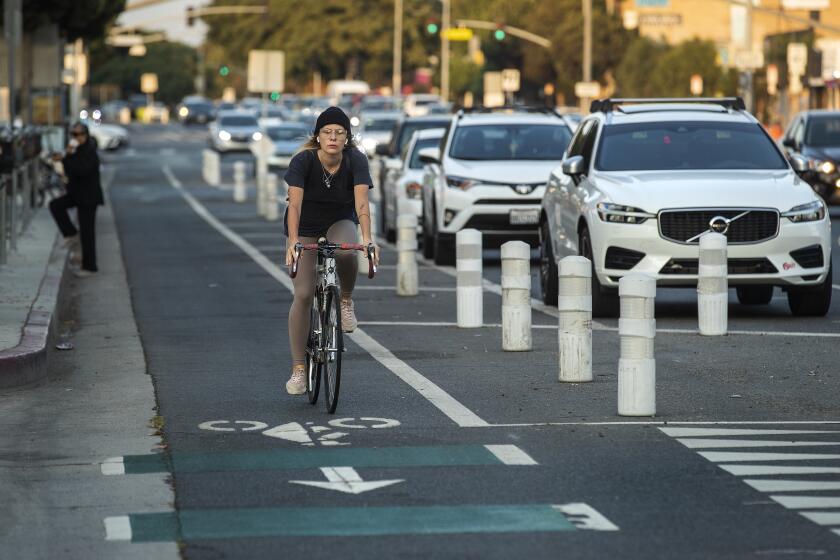Tunneling into a colorful past
- Share via
What a strange ride it has been for L.A.’s first subway.
Shut down in 1955, the Belmont Tunnel went from being a commuter route for rail passengers between downtown and the Westlake district to a storage site for survival rations, a holding cell for impounded vehicles, a movie set and, unofficially, a giant graffiti canvas and field of study for urban explorers.
Along the way, the mile-long subterranean route acquired an aura of mystery.
“I used to hop the fence and . . . find half-burnt candles, chalk drawings of odd stick figures, and altar-type things, flowers and cornmeal, spread around,” one tunnel visitor wrote on the Flickr photo website. “One night we found two headless chickens. One was black and the other was white.”
Another tunnel trekker found, among the trash, a nurse’s excuse for a student “to leave Belmont High School. . . . It’s kind of hard to imagine this as the choice hangout for someone ditching school.”
Still another underground adventurer discovered an abandoned car deep inside. Was it a forgotten impound?
The tunnel’s grim fate was, of course, unforeseen by those who attended the grand opening of the Pacific Electric Railroad’s subway in 1925, an event highlighted by the christening of a Red Car with a bottle of ginger ale (ahem, it was Prohibition).
The $5-million system -- such expense! -- enabled passengers to board a trolley at 4th and Hill streets and beat the traffic by traveling underground to the mouth of the tunnel at 2nd Street, near the intersection of Beverly and Glendale boulevards. From there, the trolley clanked along through the pre-smog air to Hollywood.
As the years went by, Los Angeles became infected with automania. Citizens moved to the suburbs and preferred to leave the driving to themselves, and complaints about train-versus-car accidents increased. Ridership declined.
The subway was shut down in 1955, its tracks ripped out. The last Red Car on that route carried a destination sign that said, “To Oblivion.”
Then began the weird afterlife of the tunnel.
During the Cold War, it was used to store 329,700 pounds of crackers, said to be enough to feed 69,940 people for 14 days after a nuclear attack. (How the 69,940 would be chosen was not revealed).
Later, the tunnel took in vehicles seized in drug cases. The cars didn’t squash any of the crackers; that food had been shipped to Utah in 1969 after the tunnel sprang a leak.
In the mid-1970s, Hollywood came calling, giving the tunnel a role in the movie “MacArthur,” starring Gregory Peck. It stood in for the Malinta Tunnel on Corregidor Island in the Philippines, the scene of heavy fighting during World War II.
Hopes of resuscitating the subway as a rail service ended in the 1970s when one portion of the tunnel was filled when foundations for the Bonaventure Hotel were built. No one took much notice. What use could there be for an urban rail line in this modern age anyway?
By the early 1980s, The Times reported, the tunnel area had become “the internationally recognized epicenter of West Coast graffiti . . . featured in magazines, photography books. . . . Taggers come from all over.”
And then a new mystery cropped up: The tunnel disappeared, sort of. At least its mouth was no longer visible to passersby on 2nd Street.
What happened was that the Belmont Station Apartments, a 275-unit complex, opened last year on the site of an old rail yard in front of the opening.
Actually, the tunnel’s terminus can still be glimpsed from a side street, Toluca Street, as can an old electric substation, Toluca No. 51, which provided the power for the subway cars. The transformation of the two landmarks is startling.
All the graffiti was erased by sandblasting, which was no easy task.
“There were between 150 and 200 coats of paint on the station,” said Paveena Prayonsirisak, the apartment manager. “I took a little chip myself. This is a part of history.”
The tunnel, now sealed, is covered by artist Tait Roelofs’ colorful mural of a Red Car, which glows in the dark. That’s L.A. for you: a make-believe light at the end of a tunnel that once was part of a real-life rail transit system.
--
steveharvey9@gmail.com
More to Read
Sign up for Essential California
The most important California stories and recommendations in your inbox every morning.
You may occasionally receive promotional content from the Los Angeles Times.









